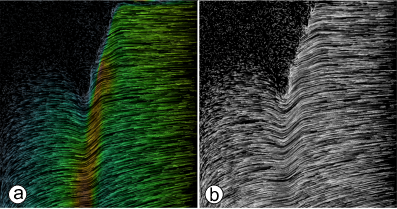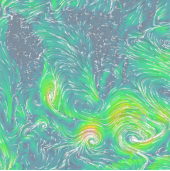Example application¶
An example application fieldanimation.examples.app can be found in the
examples
directory.
The creation of a FieldAnimation image is straightforward: just instantiate
the FieldAnimation class passing the vector field
array and call its draw method within the main rendering loop.
The visualization application shown above
depends on two OpenGL packages:
pyimgui for setting interactively the visualization parameters and GLFW for rendering the OpenGL image created by FieldAnimation in a windowing system.

The interactive GUI in this figure allows to modify the visualization parameters that FieldAnimation embeds as instance attributes:
# Default values of the class attributes
FieldAnimation.speedFactor = 0.25
FieldAnimation.decay = 0.003
FieldAnimation.decayBoost = 0.01
FieldAnimation.fadeOpacity = 0.996
FieldAnimation.color = (0.5 , 1.0 , 1.0)
FieldAnimation.palette = True
FieldAnimation.pointSize = 1.0
FieldAnimation.tracersCount = 10000
FieldAnimation.periodic = True
FieldAnimation.drawField = False
Here is a detailed description of the controls that appear in the GUI:
Field: select one of the available vector fields implemented.
Speed: set the length of the field pathlines i.e. the speed of the particles: the higher the value the longer the particle trace length.

Decay: set the life span of a particle.
Decay boost: increase points density in low intensity field areas.
Opacity: set opacity of the particles over the background image.
Color: set color of the particles according to the the field strength trough a cubehelix based color map.
Palette: set color of the particles to a constant value.

Point size: set the size of the animated particles (in pixels).

Number of Tracers: set the number of the moving particles.
Periodic: if checked points that move outside the border of the rendering window will enter from the opposite one.
Draw Field: Draw the field modulus as a background image. In this example application the field modulus is rendered trough a cubehelix color map.

